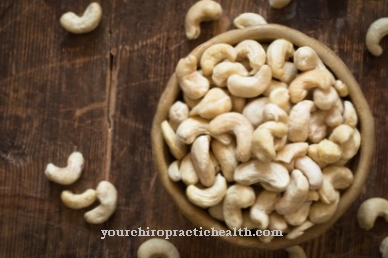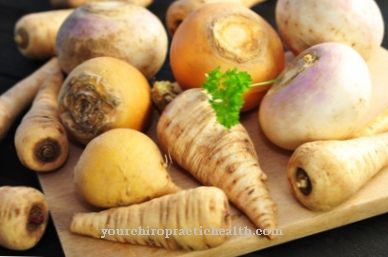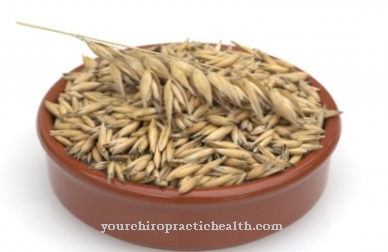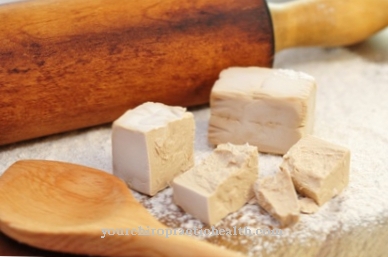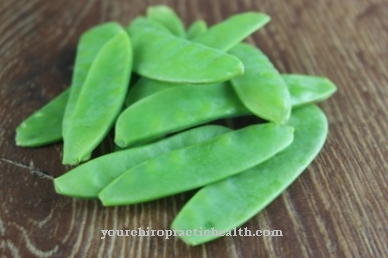As kiwi or Kiwi fruit the berry fruit of the ray pen is called. There are different types, with the majority of the commercially available kiwis coming from Actinidia deliciosa.
What you should know about the kiwi fruit

Another name for the kiwi is Chinese gooseberry. The fruits are oval to cylindrical and are up to eight inches long and five inches wide. They can be flattened on either side. The skin of the kiwi is green or brown and mostly thin. It also has a fur-like surface with fine hair that is somewhat reminiscent of felt. The inside of the kiwi fruit is unmistakable.
Its color is light to dark green on the outer edge. The inner fruit axis, however, is cream-colored and is fleshy. Kiwis are usually very juicy. Radial axes can be seen in the cross section of the kiwi. Around the inner, lighter ring of the flesh is a ring of black seeds. The name kiwi was derived from the kiwi bird for marketing reasons and has been in use in New Zealand since 1959. The kiwi fruit itself originally comes from southern China. From there it was imported to New Zealand at the beginning of the 20th century. Today Italy is the world's leading kiwi producer, followed by Chile, Greece, New Zealand, Turkey, France and Japan. Kiwis are still grown in Taiwan and China to this day.
There are different types of kiwi fruit - including Allison, Bruno, Abbott and Monty. However, the Hayward variety is the world leader. It impresses with its taste and long shelf life. In addition, the fruits are on average larger than other kiwi varieties.
The kiwi has been found in Germany for around 40 years and has become a very popular type of fruit. So-called gold kiwis with yellow pulp and smooth skin can now also be found in stores. You can find them in supermarkets and in the fruit and vegetable shops all year round for about the same price. Kiwis are no longer seasonal. The taste of the kiwi is very peculiar and has a high recognition value. The flesh is tart and sweet, with yellow kiwis being a little sweeter than green and may have a light banana or mango taste.
Importance to health
The fruits have a moderate calorie content and very little fat. Because they are high in fiber and some vitamins, they are particularly suitable for people who want to lose weight.
In summer, kiwis are particularly popular, as the acidic is refreshing and largely covers the daily vitamin requirement. Because of their ingredients and minerals, they are also suitable as snacks between meals that can be enjoyed without regrets.
Ingredients & nutritional values
| Nutritional information | Amount per 100 gram |
| Calories 61 | Fat content 0.5 g |
| cholesterol 0 mg | sodium 3 mg |
| potassium 312 mg | carbohydrates 15 g |
| protein 1.1 g | vitamin C 92.7 mg |
Kiwis have about twice as much vitamin C as oranges. Even one large kiwi can cover the daily requirement for vitamin C. There are between 80 and 120 milligrams of the vitamin in 100 grams of fruit. Kiwis also contain B and E vitamins and various minerals.
These include iron, calcium, potassium, magnesium, and phosphorus. In addition, kiwi fruits contain omega-3 fatty acids and antioxidants. A kiwi has around 61 kilocalories and contains valuable fiber. In addition, the enzyme actinidin is found in kiwi fruit, which leads to protein breakdown. When raw, the fruits should not be eaten or mixed with dairy products, as they will then take on a bitter taste.
One kiwi provides 95% of an adult's vitamin C requirement. It makes up 15% for potassium, 5% for calcium and 8% for magnesium.
Intolerances & allergies
In principle, humans can be allergic to almost any food or at least have an intolerance. Most foods are mostly intolerances that can be traced back to enzyme defects. With the kiwi, these often occur in conjunction with other allergies. The name for this is cross allergy. Often times, people who have hay fever problems suffer from food intolerances. Pollen allergy sufferers therefore have a very high risk of developing such cross allergies. Kiwifruit can also cause allergic reactions.
Food allergies usually occur a short time after consumption. Late reactions, however, are rather rare. Allergic reactions to kiwifruit are mainly restricted to the mouth and throat. The lining of the tongue and mouth can become inflamed. This can also lead to the formation of bubbles. Itching in the mouth area also sometimes occurs. The acid in kiwi fruit can also lead to burning and hypersensitivity reactions.
Shopping & kitchen tips
When buying kiwi, particular attention should be paid to the quality. They are packaged or available in pieces from retailers. Often times, kiwis are still quite tough when shopping. This shows that they are not yet ripe, whereby they usually ripen and become softer. In some cases, however, kiwi fruits can stay hard and hardly develop any taste.
Kiwis are best bought when they give a little under light pressure. In this case, the kiwi has the best texture and a pleasant aroma. Yellow kiwis usually come into stores when they are ripe and can be consumed immediately. Correspondingly, however, they also last less long.
At room temperature, ripe kiwis keep for about a day or two before they become very soft or even mushy. Otherwise, green kiwis will stay fresh in the refrigerator for up to two weeks, while yellow ones will keep for a maximum of one week.
To scoop out the pulp, all you have to do is cut the kiwi fruit in half. However, it can also be processed into cubes or slices. The pulp can also be mashed. To do this, it must first be peeled with a vegetable peeler or sharp knife.
Preparation tips
The pulp of ripe kiwi fruit can be processed into fruit pulp, which can be used, for example, as a topping for fruit salads, ice cream or creams. In addition, kiwis can be processed with milk to make fruit shakes. Another option is to use pulp, milk, and crushed ice to make ice cream. Kiwis go well with almost anything.
They can be used as a topping for tropical fruit cakes or as a side dish for coconut desserts. Kiwis are also eaten with rice pudding, whereby they should either be added before consumption or briefly doused with hot water. As a result, the protein-decomposing enzyme either has no way of working or is completely destroyed. The same applies to the use of kiwifruit in quark or yoghurt. This can prevent the bitter taste of dairy products due to decomposition.
Another way of using kiwis in the kitchen is to make them into cocktails or fruit punch.


